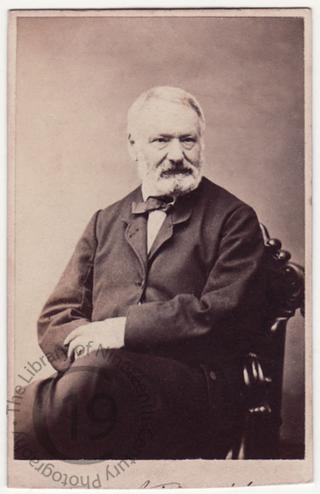
Victor Hugo
A carte-de-visite portrait of the novelist Victor Hugo (1802-1885).
Victor Hugo was born in Besançon, the son of an officer in Napoléon's army. Brought up in Naples, Spain and Pairs, Hugo began to write poetry and verse tragedies in early adolescence. His first collection of verse was published in 1822, and his first novel the following year. His historical novel The Hunchback of Notre Dame was published in 1831 and became an immediate success, his lyrical style and rich rhythms marking him out as the champion of Romanticism against French Classicism.
In 1822 Hugo married Adèle Foucher, the daughter of an officer in the Ministry of War. Intensely sexual his whole life, Hugo also had a life-long affair with the actress Julie Drouet, beginning in the early 1830's and only ending with her death in 1882, and there were many other affairs of shorter duration. Towards the end of his life he suffered a stroke during a liaison with his maid, Blanche Lavin. Adèle also had affairs, most notably with Hugo's friend Saint-Beuve. In 1863 she published a biography of her husband, and died in 1868.
A staunch Republican and an active politician during the Second Republic which followed the 1848 revolution, Hugo was forced to flee Paris when Napoleon III seized power and was declared Emperor in 1851. He went into exile first in Brussels, then in Jersey, and finally in Guernsey. The Emperor granted an amnesty to all political exiles in 1859, but Hugo chose to ignore the offer. His most famous work Les Misérables appeared in 1864, an epic story of social injustice which divided critics but was a huge popular success. He returned to France in 1870 when the Third Republic on the declaration of the Third Republic, witnessed the Siege of Paris, but escaped to Brussels during the Paris Commune, until he was expelled from there for harbouring political radicals, at which point he went to Luxembourg. On his return to Paris in 1876 he was a elected a Senator. He died in Paris on 22 May 1885. He was given a state funeral befitting a hero, which two million people attended, and buried in the Panthéon.
Photographed by the London Stereoscopic and Photographic Company.
An inked inscription verso in a fine period hand reads: ‘Obtained from London, Aug. 21, 1866’.
Code: 124340




